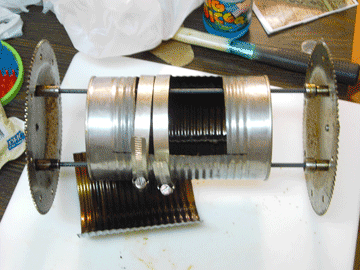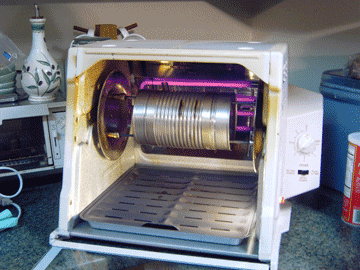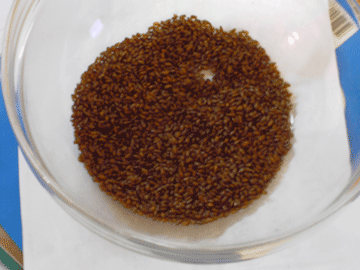Tabletop
Grain Roaster
A simple idea, but a very successful project.. Previous roasting attempts were done in the usual homebrew method - on a screen in the oven. I wasn't happy with the evenness of the roast - and by the time most of the grain was at the color I wanted. a good number of keernels were burned. I was wanting to do something more professional, something that would provide a more uniform result, and at the same time use a method that I could do in my kitchen with a reasonable amount of grain at a time.
For centuries, roasting malt has been done in rotating barrels over a fire - a grain rotisserie. I had thought of doing something with the rotisserie on my outdoor barbeque grill, but didn't want the charcoal taste in the grain. After all, I was going to be using this system for making modern beers as well as for medieval beers. But a quick inspection of the kitchen revealed the answer - a Ronco Showtime indoor rotisserie grill.
The roaster barrel is simple, it is a 48 ounce juice can with holes punched in each end to allow me to insert the spit rods through the can, and several dozen small holes punched in each end to allow steam to escape and air to circulate. The loading port is simply cut into the side of the can, and a cover was cut from a second can (as the cans were ribbed, I had to make a hatch that was ribbed as well). Standard 4 1/2 inch automotive hose clamps hold the cover in place. A strip cut from the length of the second can, with a small tab on each end, was bolted in place on the inside of the roasting can to give a 'lip' to lift and drop some the grains each rotation (like a small cement mixer).

Here is the roaster opened up and ready to load. The color inside comes from heating the empty roaster for a few hours in the rotisserie - most food cans have a food-safe lining sprayed on, and I wanted to burn it off and remove any off colors or flavors it might impart to the grain. After the dry heating, I washed the inside of the roaster (be careful, the edges are sharp and there is litttle that can be done about that - the cans are thin). After scouring the can, I put it back in to dry, and then it was ready to load.

The first test batch was done with 3 ounces of malted rice, soaked for 20 minutes in water, drained, then added. to the roaster. The Showtime rotisserie is a fixed temperature unit, there are two positions for the rotisserie spit - close to the heating element, or farther away. I used the farther setting. Because we were unsure about the time it would take, we started with a 10 minute roast. The grains were just starting to get dry at the end of this roast. The second roast followed immeidately, at 20 minutes, the grains were dry but not colored very much. A third roast, also 20 minutes, produced the desired result. (the door is open only for the photo - close it to roast grain)

Here is the end result - the grain is at about a 9 or 10 roast on the coffee bean scale, has a nice nutty flavor without being burnt, and a wonderful roasted, but not burnt, armoa that you can just bury your face into. The roast is very uniform, both on the individual grains and through the whole batch, and the temperature was high enough to change the sugar state and produce the glossy outside on the grains.
A simple idea, but a very successful project.. Previous roasting attempts were done in the usual homebrew method - on a screen in the oven. I wasn't happy with the evenness of the roast - and by the time most of the grain was at the color I wanted. a good number of keernels were burned. I was wanting to do something more professional, something that would provide a more uniform result, and at the same time use a method that I could do in my kitchen with a reasonable amount of grain at a time.
For centuries, roasting malt has been done in rotating barrels over a fire - a grain rotisserie. I had thought of doing something with the rotisserie on my outdoor barbeque grill, but didn't want the charcoal taste in the grain. After all, I was going to be using this system for making modern beers as well as for medieval beers. But a quick inspection of the kitchen revealed the answer - a Ronco Showtime indoor rotisserie grill.
The roaster barrel is simple, it is a 48 ounce juice can with holes punched in each end to allow me to insert the spit rods through the can, and several dozen small holes punched in each end to allow steam to escape and air to circulate. The loading port is simply cut into the side of the can, and a cover was cut from a second can (as the cans were ribbed, I had to make a hatch that was ribbed as well). Standard 4 1/2 inch automotive hose clamps hold the cover in place. A strip cut from the length of the second can, with a small tab on each end, was bolted in place on the inside of the roasting can to give a 'lip' to lift and drop some the grains each rotation (like a small cement mixer).

Here is the roaster opened up and ready to load. The color inside comes from heating the empty roaster for a few hours in the rotisserie - most food cans have a food-safe lining sprayed on, and I wanted to burn it off and remove any off colors or flavors it might impart to the grain. After the dry heating, I washed the inside of the roaster (be careful, the edges are sharp and there is litttle that can be done about that - the cans are thin). After scouring the can, I put it back in to dry, and then it was ready to load.

The first test batch was done with 3 ounces of malted rice, soaked for 20 minutes in water, drained, then added. to the roaster. The Showtime rotisserie is a fixed temperature unit, there are two positions for the rotisserie spit - close to the heating element, or farther away. I used the farther setting. Because we were unsure about the time it would take, we started with a 10 minute roast. The grains were just starting to get dry at the end of this roast. The second roast followed immeidately, at 20 minutes, the grains were dry but not colored very much. A third roast, also 20 minutes, produced the desired result. (the door is open only for the photo - close it to roast grain)

Here is the end result - the grain is at about a 9 or 10 roast on the coffee bean scale, has a nice nutty flavor without being burnt, and a wonderful roasted, but not burnt, armoa that you can just bury your face into. The roast is very uniform, both on the individual grains and through the whole batch, and the temperature was high enough to change the sugar state and produce the glossy outside on the grains.